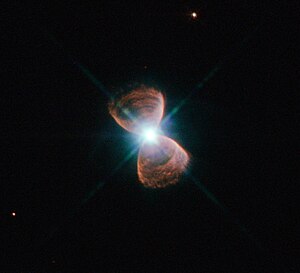Bipolar nebula
Appearance

Abipolar nebulais a type of nebula characterized by two lobes either side of a central star. About 10-20% ofplanetary nebulaeare bipolar.[2]
Formation
[edit]Though the exact causes of this nebular structure are not known, it is often thought to imply the presence of a binary central star with a period of a few days to a few years. As one of the two stars expelled its outer layers, the other disrupted the outflow of material to form the bipolar shape.[3]
Examples
[edit]
- Homunculus NebulaaroundEta Carinae[4][5][6][7]
- Hubble 5[8]
- M2-9 – TheWings of a Butterfly Nebula[9][10][11]
- OH231.8+4.2 – TheCalabash Nebulaor Rotten Egg Nebula[12][13][14][15]
- Mz3 (or Menzel 3) – TheAnt Nebula[16][17][18]
- CRL 618 - TheWestbrook Nebula[19]
- CRL 2688 – TheEgg Nebula[20][21][22][23]
- HD 44179 – TheRed Rectangle Nebula[24][25][26]
- MyCn18 – TheEngraved Hourglass Nebula[27][28][29][30][31]
- He2-104 – TheSouthern Crab Nebula[32][33][34]
- TheBoomerang Nebula[35][36][37][38][39]
- NGC 2346– Also known as the Butterfly Nebula[40]
- NGC 6302– The Bug or Butterfly Nebula
- KjPn 8 Nebula– The largest (in angular size) bipolar planetary nebula.[41]
References
[edit]- ^"Bizarre alignment of planetary nebulae".ESA/Hubble Press Release.Retrieved6 September2013.
- ^The Macquarie/AAO/Strasbourg Hα Planetary Nebula Catalogue: MASH,Parker et al. 2006, MNRAS, 373, 79
- ^Binary Progenitor Models for Bipolar Planetary Nebulae,Soker 1998, ApJ, 496, 833
- ^NewsCenter - Doomed Star Eta Carinae (06/10/1996) - Release Images.HubbleSite (10 June 1996). Retrieved on 26 November 2010.
- ^Nemiroff, R.; Bonnell, J., eds. (12 July 1995)."Eta Carinae Before Explosion".Astronomy Picture of the Day.NASA.Retrieved26 November2010.
- ^Nemiroff, R.; Bonnell, J., eds. (26 March 2006)."Doomed Star Eta Carinae".Astronomy Picture of the Day.NASA.Retrieved26 November2010.
- ^Eta Carinae Nebula (NGC 3372).Daviddarling.info (1 February 2007). Retrieved on 26 November 2010.
- ^HubbleSite – NewsCenter –Hubble Witnesses the Final Blaze of Glory of Sun-Like Stars(12/17/1997) – Release Images
- ^Nemiroff, R.; Bonnell, J., eds. (12 June 2005)."M2 9: Wings of a Butterfly Nebula".Astronomy Picture of the Day.NASA.Retrieved26 November2010.
- ^Nemiroff, R.; Bonnell, J., eds. (21 October 1997)."The Butterfly Planetary Nebula".Astronomy Picture of the Day.NASA.Retrieved26 November2010.
- ^Butterfly Nebula (M 2-9).Daviddarling.info (1 February 2007). Retrieved on 26 November 2010.
- ^NewsCenter - The "Rotten Egg" Nebula: A Planetary Nebula in the Making (10/19/1999) - Introduction.HubbleSite (19 October 1999). Retrieved on 26 November 2010.
- ^APOD: 1 November 1999 - The Rotten Egg Planetary Nebula.Antwrp.gsfc.nasa.gov (1 November 1999). Retrieved on 26 November 2010.
- ^Nemiroff, R.; Bonnell, J., eds. (3 September 2001)."The Making of the Rotten Egg Nebula".Astronomy Picture of the Day.NASA.Retrieved26 November2010.
- ^Calabash Nebula (OH231.8+4.2).Daviddarling.info (1 February 2007). Retrieved on 26 November 2010.
- ^NewsCenter - Astro-Entomology? Ant-like Space Structure Previews Death of Our Sun (02/01/2001) - Introduction.HubbleSite (1 February 2001). Retrieved on 26 November 2010.
- ^Nemiroff, R.; Bonnell, J., eds. (1 May 2005)."Planetary Nebula Mz3: The Ant Nebula".Astronomy Picture of the Day.NASA.Retrieved26 November2010.
- ^Ant Nebula (Menzel 3).Daviddarling.info (1 February 2007). Retrieved on 26 November 2010.
- ^Tafoya, D.; Loinard, L.; Vlemmings, W.H.T.; Marti-Vidal, I.; Pech, G. (22 July 2013)."Rapid angular expansion of the ionized core of CRL 618"(PDF).Astronomy and Astrophysics.556:A35.doi:10.1051/0004-6361/201321704.Retrieved15 November2020.
- ^NewsCenter - Hubble Finds Searchlight Beams and Multiple Arcs around a Dying Star (01/16/1996) - Introduction.HubbleSite (16 January 1996). Retrieved on 26 November 2010.
- ^Nemiroff, R.; Bonnell, J., eds. (26 June 1999)."Shells in the Egg Nebula".Astronomy Picture of the Day.NASA.Retrieved26 November2010.
- ^Nemiroff, R.; Bonnell, J., eds. (9 April 2003)."The Egg Nebula in Polarized Light".Astronomy Picture of the Day.NASA.Retrieved26 November2010.
- ^Egg Nebula (CRL 2688).Daviddarling.info (1 February 2007). Retrieved on 26 November 2010.
- ^NewsCenter - Dying Star Sculpts Rungs of Gas and Dust (05/11/2004) - Release Images.HubbleSite (11 May 2004). Retrieved on 26 November 2010.
- ^Nemiroff, R.; Bonnell, J., eds. (13 May 2004)."Rungs of the Red Rectangle".Astronomy Picture of the Day.NASA.Retrieved26 November2010.
- ^Red Rectangle.Daviddarling.info (1 February 2007). Retrieved on 26 November 2010.
- ^NewsCenter - Hubble Finds an Hourglass Nebula around a Dying Star (01/16/1996) - Release Images.HubbleSite (16 January 1996). Retrieved on 26 November 2010.
- ^Nemiroff, R.; Bonnell, J., eds. (18 January 1996)."MyCn18: An Hourglass Nebula".Astronomy Picture of the Day.NASA.Retrieved26 November2010.
- ^Nemiroff, R.; Bonnell, J., eds. (15 June 2002)."MyCn18: An Hourglass Nebula".Astronomy Picture of the Day.NASA.Retrieved26 November2010.
- ^Nemiroff, R.; Bonnell, J., eds. (9 February 1996)."The Eye of an Hourglass Nebula".Astronomy Picture of the Day.NASA.Retrieved26 November2010.
- ^Hourglass Nebula (MyCn 18).Daviddarling.info (1 February 2007). Retrieved on 26 November 2010.
- ^NewsCenter - Symbiotic Star Blows Bubbles into Space (08/24/1999) - Release Images.HubbleSite (24 August 1999). Retrieved on 26 November 2010.
- ^Nemiroff, R.; Bonnell, J., eds. (31 August 1999)."Symbiotic Star Bubbles".Astronomy Picture of the Day.NASA.Retrieved26 November2010.
- ^Southern Crab Nebula (He2-104)Archived9 October 2006 at theWayback Machine.Daviddarling.info (1 February 2007). Retrieved on 26 November 2010.
- ^NewsCenter - Hubble Catches Scattered Light from the Boomerang Nebula (09/13/2005) - Release Images.HubbleSite (13 September 2005). Retrieved on 26 November 2010.
- ^Nemiroff, R.; Bonnell, J., eds. (14 September 2005)."The Boomerang Nebula in Polarized Light".Astronomy Picture of the Day.NASA.Retrieved26 November2010.
- ^Nemiroff, R.; Bonnell, J., eds. (20 February 2003)."Cold Wind from the Boomerang Nebula".Astronomy Picture of the Day.NASA.Retrieved26 November2010.
- ^Nemiroff, R.; Bonnell, J., eds. (15 October 1997)."Cold Wind From The Boomerang Nebula".Astronomy Picture of the Day.NASA.Retrieved26 November2010.
- ^Boomerang Nebula.Daviddarling.info (1 February 2007). Retrieved on 26 November 2010.
- ^APOD: 28 October 2001 – NGC 2346: A Butterfly-Shaped Planetary Nebula
- ^López, J.A; Vazquez, R.; Rodriguez, L.F. (10 December 1995). "The discovery of a bipolar, rotating, episodic jet (BRET) in the planetary nebula KjPn 8".The Astrophysical Journal.455:L63–L66.doi:10.1086/309801.
